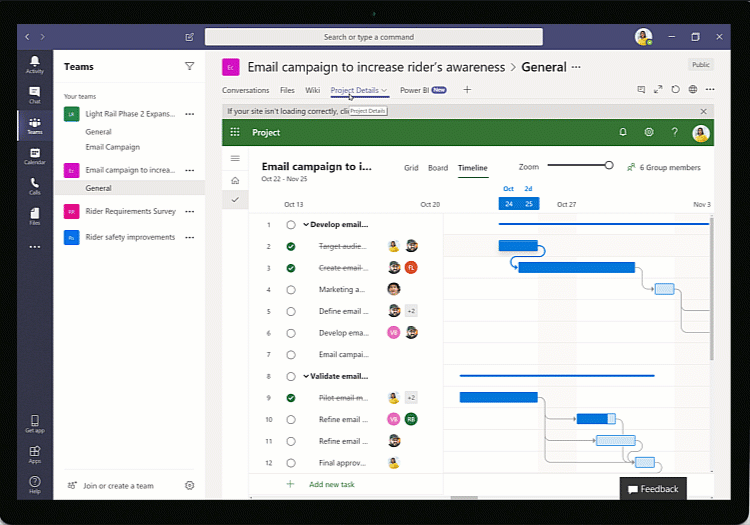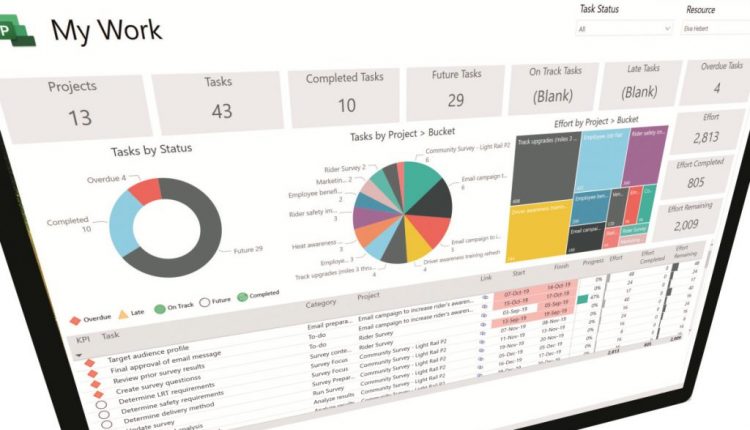Microsoft Project upgrade launches in general availability with a focus on collaboration
Microsoft is rolling out an all-new version of its project management software known as Microsoft Project, as the company sets out to better equip teams to “collaborate on projects more efficiently.”
Microsoft Project doesn’t garner the same attention as the myriad other business-focused tools in the Microsoft Office family of products, but it was actually one of the first apps available at Windows’ launch back in the 1980s. At its core, Microsoft Project is all about enabling teams to schedule and assign tasks, track progress, manage budgets, and more. Much has changed over the years, of course, and the cloud now plays a pivotal part in Project’s appeal, with every member of a team able to have the same view of a project at the same time.
Last September, Microsoft announced plans for a new version of Microsoft Project, and in the intervening months it has rolled out iterations of the various features, though they may not have been visible for everyone. From this month, however, the features are being pushed into general availability, meaning that the new Microsoft Project will be live for everyone around the world shortly.
Collaboration
The broader Project interface has also been redesigned to make it easier to create new tasks, add new members, and switch between grids, boards, or timeline charts. But digging down into the new Project platform reveals that Microsoft is pushing deeper integrations with its various other business tools, including Office and its chat-based collaboration tool Teams.
Microsoft Teams now claims more than half-a-million organizations as customers, and at least 13 million daily active users, so tying this crucial team communication tool into its project management software makes a great deal of sense. This will prove particularly useful for nationally or globally distributed teams, who will now have a seamless integration between projects, covering file-sharing, calendar schedules, messaging, and more.

Users can also create interactive dashboards for specific parts of a project in Microsoft’s Power BI analytics service, and then get a “big picture” view across all projects using a new feature called Roadmap. Until now, Roadmap has been off by default company admins have had to manually activate the feature since its first release earlier this year. With the general availability of the new Microsoft Project, this will become a default offering.
In essence, Roadmap is designed to surface insights and provide a broad overview of all projects visually this includes viewing the status of all tasks, projects, portfolios, and programs. Users can also use filters to view only specific tasks, milestones, or phases of a given project.

Project management
There are countless project management tools out in the wild, and investors have been lining up to back them — in the past year alone, Asana raised $50 million at $1.5 billion valuation, while Monday.com secured $150 million at $1.9 billion valuation. Elsewhere, the likes of Mavenlink and Sitetracker have raised nearly $60 million between them.
What Microsoft has in its corner, of course, is sheer scale as one of the leading business software companies on the planet. It also has Windows and Azure cloud services up its proverbial sleeve. Combined, this gives Microsoft a major advantage in terms of the promise of integrated project management and communication processes, that work online everywhere.
The official release of the new Microsoft Project actually kickstarted a couple of weeks back, though the company is now ramping up the rollout to Project Online subscribers around the world. Users will receive a notification when the new Microsoft Project is available for their organization.
Additionally, this upgrade is seemingly just the first in a number of updates for Microsoft Project in the next year or so, Microsoft is promising a bunch of new tools covering budget analysis, resource management, and expenses tracking.


